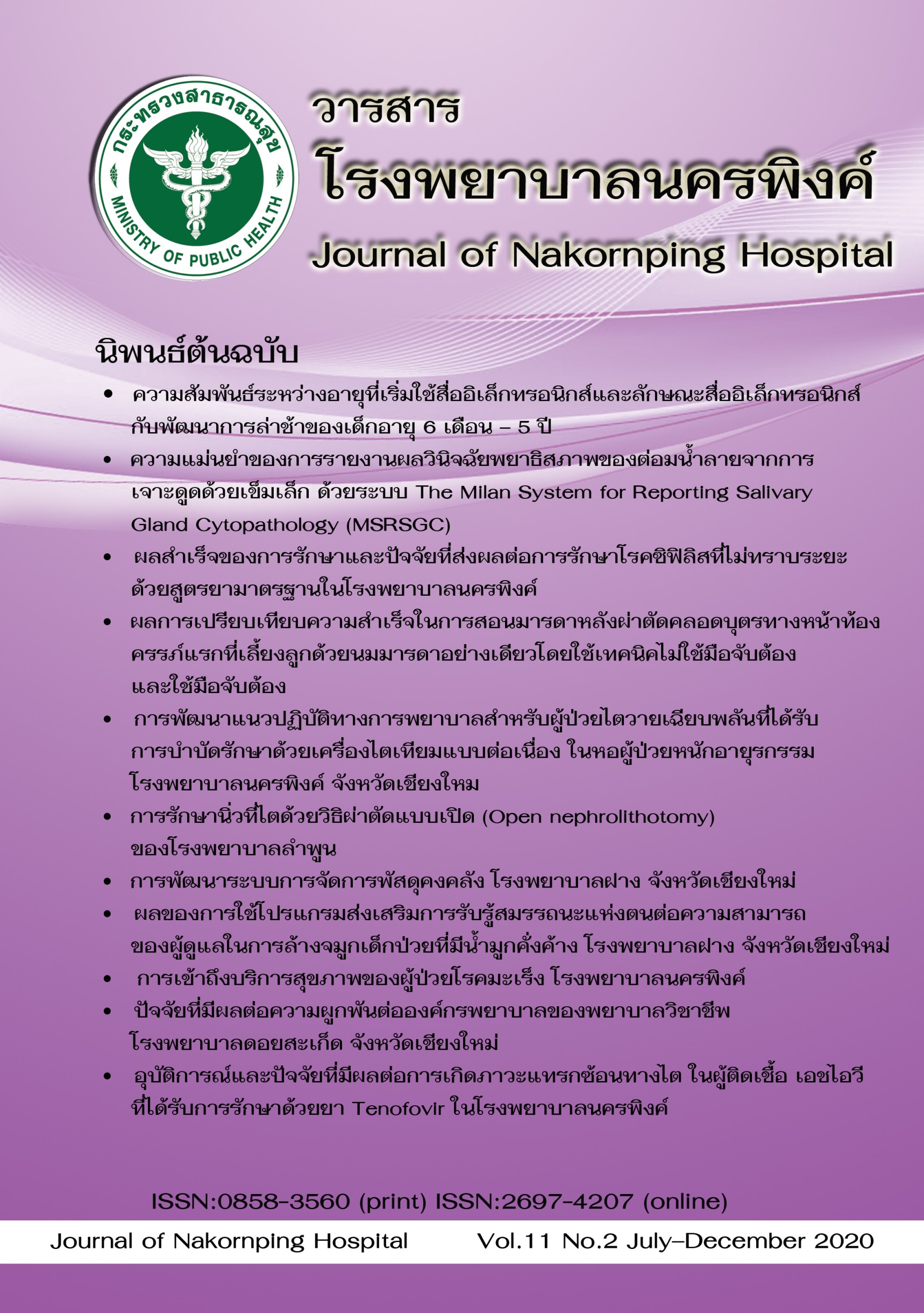ความแม่นยำของการรายงานผลวินิจฉัยพยาธิสภาพของต่อมน้ำลายจากการเจาะดูดด้วยเข็มเล็ก ด้วยระบบ The Milan System for Reporting Salivary Gland Cytopathology (MSRSGC)
คำสำคัญ:
fine-needle aspiration, FNA, Milan System for Reporting Salivary Gland Cytopathology, MSRSGCบทคัดย่อ
บทนำ: The Milan System for Reporting Salivary Gland Cytopathology (MSRSGC) เป็นระบบการรายงานผลทางเซลล์วิทยาของต่อมน้ำลาย ที่ประกาศใช้ปี 2018 โดย American Society of Cytopathology (ASC) and the International Academy of Cytology (IAC) การศึกษานี้มีจุดประสงค์เพื่อศึกษาความแม่นยำของการรายงานผลระบบ The Milan System for Reporting Salivary Gland Cytopathology (MSRSGC) เปรียบเทียบกับการรายงานผลการวินิจฉัยแบบอธิบายเช่นเดิม (Descriptive interpretation) ในการวินิจฉัยทางเซลล์วิทยาของพยาธิสภาพต่อมน้ำลาย
วิธีการศึกษา: เป็นการศึกษาภาคตัดขวางเชิงวิเคราะห์แบบเก็บข้อมูลย้อนหลัง ในกลุ่มผู้ป่วยที่คลำได้ก้อนบริเวณต่อมน้ำลายระหว่างปี ค.ศ. 2015 – 2020 ที่ได้รับการตรวจ FNA และมีผลวินิจฉัยชิ้นเนื้อทางพยาธิวิทยา สไลด์แก้วของผู้ป่วยจะถูกอ่านทางเซลล์วิทยาใหม่โดย พยาธิแพทย์สามท่าน ทำการรายงานด้วยระบบ MSRSGC ที่แบ่งการรายงานออกเป็น 6 กลุ่ม โดยใช้มติ 2 ใน 3 เปรียบเทียบกับวิธีระบบการอธิบายวินิจฉัยแบบเดิม (Descriptive Interpretation) และผลตรวจชิ้นเนื้อทางพยาธิวิทยา
ผลการศึกษา: จากการศึกษาผู้ป่วยทั้งหมด 35 ราย เป็นเพศหญิง 23 ราย (65.7%) อายุเฉลี่ย 50.6 ปี (SD17.6) และร้อยละ 85 มีขนาดก้อนมากกว่า 2 ซม. ซึ่งการศึกษานี้พบว่าระบบ MSRSGC มีความแม่นยำ ความไว และความจำเพาะร้อยละ 91.43 (95%CI 76.94-98.20), 90.3 (95%CI 74.2-98.0%) และ 100.0 (95%CI 39.8-100%) ขณะที่วิธีระบบการอธิบายวินิจฉัยแบบเดิม (Descriptive Interpretation) มีความแม่นยำ ความไว และความจำเพาะร้อยละ 80.0 (95%CI 63.06 – 91.56) 80.6 (95%CI 62.5 – 92.5%) และ 75.0 (95%CI 19.4 – 99.4%) ตามลำดับ สรุปผลการศึกษาการรายงานผลด้วยระบบ MSRSGC มีความแม่นยำ, ความไว และความจำเพาะสูง และสามารถนำไปเป็นมาตรฐานในการรายงานผลการตรวจทางเซลล์วิทยาของต่อมน้ำลาย
References
Viswanathan K, Sung S, Scognamiglio T, Yang GC, Siddiqui MT, Rao RA. The role of the Milan system for reporting salivary gland cytopathology: a 5 year institutional experience. Cancer Cytopathol. 2018;126(8):541-551.
Del Signore AG, Megwalu UC. The rising incidence of major salivary gland cancer in the United States. Ear Nose Throat J. 2017;96(3):E13-E16.
Batsakis JG, Regezi JA. The pathology of head and neck tumors: salivary glands, part 1. Head Neck Surg. 1978;1(1):59-68.
Jayaram G, Dashini M. Evaluation of fine needle aspiration cytology of salivary glands: an analysis of 141 cases. Malays J Pathol. 2001;23(2):93-100.
Mukunyadzi P. Review of fine-needle aspiration cytology of salivary gland neoplasms, with emphasis on differential diagnosis. Am J Clin Pathol. 2002;118 Suppl:S100-15.
Schindler S, Nayar R, Dutra J, Bedrossian CW. Diagnostic challenges in aspiration cytology of the salivary glands. Semin Diagn Pathol. 2001;18(2):124-46.
Ivanová S, Slobodníková J, Janská E, Jozefáková J. Fine needle aspiration biopsy in a diagnostic workup algorithm of salivary gland tumors. Neoplasma. 2003;50(2):144-147.
Faquin WC, Rossi ED, Baloch Z, Barkan GA, Foschini MP, Kurtycz DFI, et al. The Milan System for Reporting Salivary Gland Cytopathology. Switzerland: Springer nature; 2018.
Kala C, Kala S, Khan L. The Milan System for Reporting Salivary Gland Cytopathology: An experience with the implication for risk of malignancy. J Cytol. 2019;36(3):160–164.
Kumari M, Sharma A, Singh M, Rawal G. Milan System for Reporting of Salivary Gland Cytopathology: To Recognize Accuracy of Fine Needle Aspiration and Risk of Malignancy- A 4 Years Institutional Study. IJRR. 2020;7(2): 201-207.
Downloads
เผยแพร่แล้ว
How to Cite
ฉบับ
บท
License
บทความที่ได้รับการตีพิมพ์เป็นลิขสิทธิ์ของโรงพยาบาลนครพิงค์ จ.เชียงใหม่
ข้อความที่ปรากฏในบทความแต่ละเรื่องบทความในวารสารวิชาการและวิจัยเล่มนี้เป็นความคิดเห็นส่วนตัวของผู้เขียนแต่ละท่านไม่เกี่ยวข้องกับโรงพยาบาลนครพิงค์ และบุคลากรท่านอื่นๆในโรงพยาบาลฯ ความรับผิดชอบเกี่ยวกับบทความแต่ละเรื่องผู้เขียนจะรับผิดชอบของตนเองแต่ละท่าน


